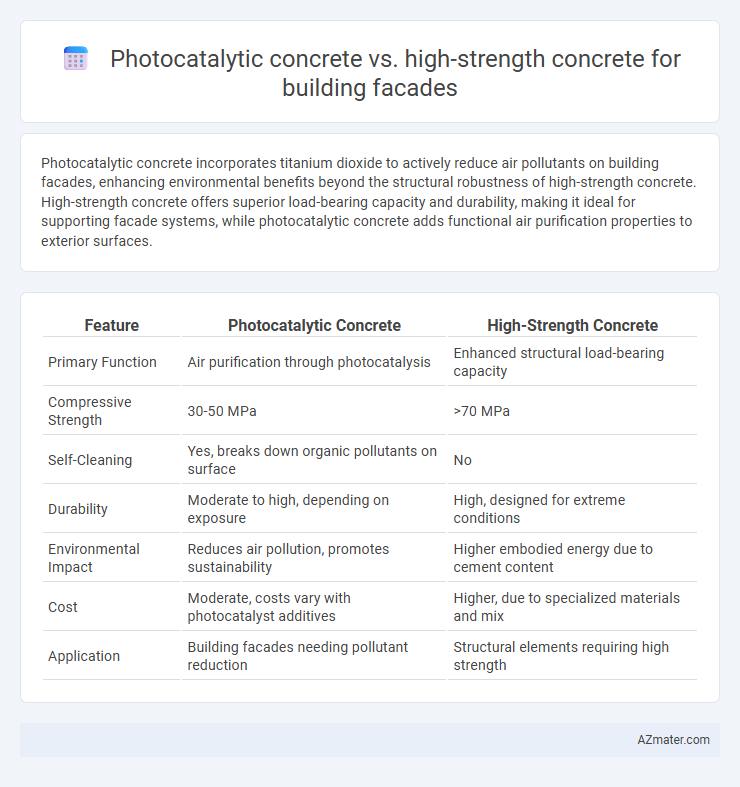Photocatalytic concrete incorporates titanium dioxide to actively reduce air pollutants on building facades, enhancing environmental benefits beyond the structural robustness of high-strength concrete. High-strength concrete offers superior load-bearing capacity and durability, making it ideal for supporting facade systems, while photocatalytic concrete adds functional air purification properties to exterior surfaces.
Table of Comparison
| Feature | Photocatalytic Concrete | High-Strength Concrete |
|---|---|---|
| Primary Function | Air purification through photocatalysis | Enhanced structural load-bearing capacity |
| Compressive Strength | 30-50 MPa | >70 MPa |
| Self-Cleaning | Yes, breaks down organic pollutants on surface | No |
| Durability | Moderate to high, depending on exposure | High, designed for extreme conditions |
| Environmental Impact | Reduces air pollution, promotes sustainability | Higher embodied energy due to cement content |
| Cost | Moderate, costs vary with photocatalyst additives | Higher, due to specialized materials and mix |
| Application | Building facades needing pollutant reduction | Structural elements requiring high strength |
Introduction to Photocatalytic and High-Strength Concrete
Photocatalytic concrete incorporates titanium dioxide (TiO2) nanoparticles that activate under UV light to break down pollutants, providing self-cleaning and air-purifying benefits for building facades. High-strength concrete is engineered with optimized cement blends and admixtures to achieve compressive strengths exceeding 6,000 psi, enhancing structural durability and load-bearing capacity. Both materials serve distinct functional purposes; photocatalytic concrete focuses on environmental performance, while high-strength concrete prioritizes mechanical resilience.
Key Differences Between Photocatalytic and High-Strength Concrete
Photocatalytic concrete incorporates titanium dioxide, enabling it to break down pollutants and self-clean building facades while high-strength concrete emphasizes compressive strength and durability for structural support. Photocatalytic concrete offers environmental benefits through air purification and reduced maintenance, whereas high-strength concrete provides enhanced load-bearing capacity essential for safety and longevity. The primary difference lies in photocatalytic concrete's functional surface properties compared to the mechanical performance focus of high-strength concrete.
Core Composition and Chemical Properties
Photocatalytic concrete incorporates titanium dioxide (TiO2) nanoparticles within its cement matrix, enabling it to break down pollutants and self-clean surfaces through photocatalytic reactions under UV light. High-strength concrete, formulated with low water-to-cement ratios and supplementary cementitious materials like silica fume or fly ash, achieves enhanced mechanical properties by refining the microstructure and reducing porosity. While photocatalytic concrete prioritizes chemical reactivity and environmental benefits, high-strength concrete emphasizes compressive strength and durability through optimized core composition and hydration chemistry.
Environmental Impact and Air Purification Benefits
Photocatalytic concrete incorporates titanium dioxide nanoparticles that actively break down air pollutants such as nitrogen oxides and volatile organic compounds, significantly improving urban air quality around building facades. High-strength concrete, while offering superior mechanical performance and durability for structural integrity, lacks intrinsic photocatalytic properties and thus does not contribute to air purification. The environmental impact of photocatalytic concrete extends beyond construction to long-term atmospheric cleaning benefits, making it a sustainable choice for eco-friendly building facades.
Structural Performance and Load-Bearing Capacity
Photocatalytic concrete integrates titanium dioxide to enhance self-cleaning and pollution-reducing properties while maintaining adequate structural performance for building facades. High-strength concrete, characterized by compressive strengths typically above 50 MPa, offers superior load-bearing capacity and durability critical for heavy structural applications. For facades requiring both aesthetic maintenance and robust structural demands, high-strength concrete generally provides enhanced mechanical performance, whereas photocatalytic concrete is favored for environmental benefits with moderate load requirements.
Applications in Building Facade Design
Photocatalytic concrete enhances building facades by providing self-cleaning and pollution-reducing properties, making it ideal for urban environments requiring sustainable design. High-strength concrete offers superior structural performance and durability, suitable for load-bearing elements and high-rise facade systems demanding enhanced mechanical resistance. Combining photocatalytic materials with high-strength concrete can optimize facade functionality by pairing environmental benefits with robust construction support.
Durability and Maintenance Requirements
Photocatalytic concrete enhances building facade durability by reducing surface pollutants and preventing mold growth through its self-cleaning properties, leading to lower maintenance demands. High-strength concrete offers superior structural integrity and resistance to environmental stressors, ensuring long-term durability but typically requires regular upkeep to address surface wear and potential cracking. Combining photocatalytic technology with high-strength concrete can optimize facade longevity by minimizing maintenance while maintaining robust mechanical performance.
Cost Analysis and Economic Viability
Photocatalytic concrete typically incurs higher initial costs due to the integration of titanium dioxide nanoparticles, which enhance air purification and reduce surface maintenance requirements, potentially lowering long-term expenses. High-strength concrete offers cost efficiency in materials and labor, driven by its superior compressive strength allowing for thinner structural elements and reduced material volume. Economic viability favors photocatalytic concrete in urban environments with stringent environmental regulations, while high-strength concrete remains competitive in standard construction scenarios prioritizing upfront cost savings.
Aesthetic Versatility and Architectural Appeal
Photocatalytic concrete offers superior aesthetic versatility for building facades by providing self-cleaning properties and maintaining a pristine appearance despite urban pollution, enhancing long-term architectural appeal. High-strength concrete delivers robust structural performance but often requires surface treatments or finishes to achieve desired visual effects, limiting inherent design flexibility. Photocatalytic concrete's ability to resist stains and promote air purification combines functionality with visual elegance, making it an innovative choice for sustainable and attractive facade designs.
Future Trends in Concrete Facade Technologies
Photocatalytic concrete integrates titanium dioxide to reduce urban pollution and self-clean surfaces, enhancing sustainability in building facades. High-strength concrete offers superior durability and load-bearing capacity, supporting innovative architectural designs and taller structures. Future trends emphasize combining photocatalytic properties with high-strength composites to develop multifunctional facades that improve environmental performance and structural resilience.

Infographic: Photocatalytic concrete vs High-strength concrete for Building facade
 azmater.com
azmater.com